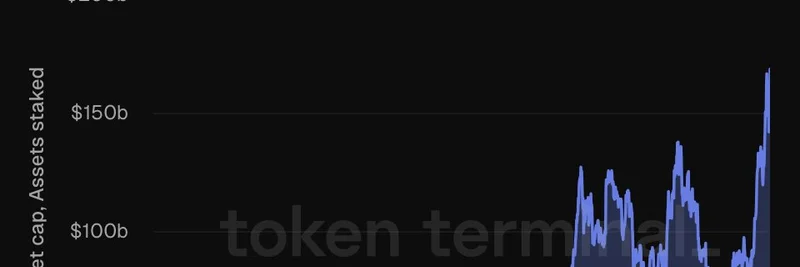If you're keeping an eye on the crypto world, especially the Ethereum ecosystem, you've probably noticed how staking has become a big deal. In a recent post on X (formerly Twitter) from Token Terminal, they dropped some eye-opening stats: there's around $170 billion worth of ETH staked right now, and a whopping $42 billion of that is handled through Lido Finance.
Breaking Down Ethereum Staking
For those new to the scene, staking is basically locking up your cryptocurrency to support the network's operations, like validating transactions on proof-of-stake blockchains such as Ethereum. In return, you earn rewards—kind of like interest on a savings account, but with crypto twists.
Ethereum switched to proof-of-stake back in 2022 with "The Merge," making staking the way to secure the network instead of energy-intensive mining. Fast forward to today, and the total value of staked ETH has ballooned to $170 billion. That's a massive pool of capital that's helping keep Ethereum running smoothly.
Lido Finance's Dominant Role
Now, enter Lido Finance—a popular liquid staking protocol. What makes Lido special? Normally, when you stake ETH directly, it's locked up, meaning you can't use it for other things like trading or lending. Lido changes that by giving you a token called stETH (staked ETH) in exchange for your deposited ETH. This stETH represents your staked amount plus rewards, and you can trade it, use it in DeFi protocols, or even swap it for meme tokens without unstaking.
According to the chart from Token Terminal, Lido's share has grown steadily alongside the overall Ethereum staking market. Starting from near zero in 2021, it's now at $42 billion, which is about 25% of the total staked ETH. That's huge dominance in the liquid staking space, making Lido a go-to for investors who want staking rewards without losing liquidity.
Why This Matters for Meme Tokens and DeFi
At Meme Insider, we focus on meme tokens, but this staking boom ties right in. With more ETH staked via platforms like Lido, there's increased liquidity flowing through DeFi. That means more capital available for fun, volatile plays like meme coins on Ethereum-based DEXs such as Uniswap.
Think about it: If you're holding stETH, you can collateralize it to borrow assets, then dive into the latest meme token hype without selling your ETH. It's like having your cake (staking rewards) and eating it too (trading memes). Plus, as Ethereum scales with updates like Dencun, which reduced fees, it opens the door for even more meme activity.
Looking Ahead
The growth shown in the chart—from humble beginnings in 2021 to peaks in 2024 and 2025—suggests staking isn't slowing down. Factors like improving yields, institutional interest, and Ethereum's roadmap could push these numbers higher. If you're a blockchain practitioner or just a crypto curious, keeping tabs on metrics from sources like Token Terminal is key to staying ahead.
Whether you're staking for steady yields or using liquid staking to fuel your meme token adventures, this data underscores Ethereum's maturing ecosystem. What's your take—will Lido keep its lead, or will competitors chip away? Drop your thoughts in the comments!



